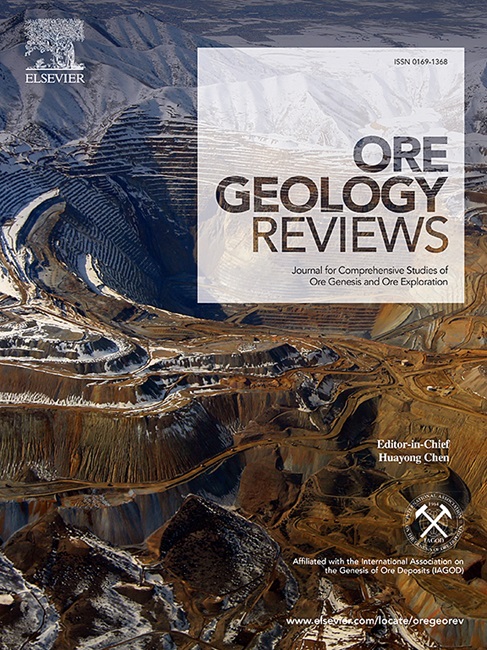Tourmaline geochemical and B isotopic constraints on pegmatite Li mineralization and exploration
IF 3.6
2区 地球科学
Q1 GEOLOGY
引用次数: 0
Abstract
Pegmatite–related deposits represent one of the most significant types of mineral deposits housing rare–metal elements such as Li, Be, Nb, Ta, Rb, Cs, and Sn. Although extensively studied for almost two centuries, the mechanism controlling the rare–metal mineralization in pegmatites remains controversial. In addition to the enrichment of rare–metal elements in the source region, differentiation processes (e.g., fractional crystallization and liquid immiscibility) after emplacement may have also contributed to the concentration and mineralization of rare–metal elements. However, compared to fractional crystallization, the role of liquid immiscibility in pegmatite mineralization has received limited attention. In this study, the element and boron (B) isotopic compositions of tourmalines from different textural zones (Zones I–VI) of the rare–metal–mineralized Koktokay No. 3 pegmatite, Altai, NW China, as well as from the altered country rock and the border zone, were analyzed to evaluate the role of liquid immiscibility in the generation of Li–mineralized pegmatites. Tourmalines display a variety of compositions, ranging from schorl and elbaite in the outer zones to elbaite in the inner zones of the Koktokay No. 3 pegmatite. Tourmalines from Zones I–III exhibit no obvious internal textures, whereas some tourmalines from Zones IV–VI have replacement textures or abrupt zonations. The distinction is attributed to the absence and presence of exsolving fluids during their formation, respectively. Tourmalines in Zones I–III and VII–VIII display less variable δ11B values (–15.07 ‰ to –12.21 ‰ and –14.16 ‰ to –13.10 ‰, respectively), reflecting a negligible B isotope fractionation produced by fractional crystallization during the pegmatite evolution. By contrast, tourmalines in Zones IV–VII exhibit more significant variations in δ11B values (–14.83 ‰ to –8.09 ‰) compared to those in Zones I–III and VII–VIII. The high δ11B tourmalines in Zones IV–VII were most likely crystallized from the fluids exsolving from the highly evolved pegmatite–forming magma. Their occurrence indicates the fluid exsolution occurring between zones IV and V, where Li mineralization began in the Koktokay No. 3 pegmatite. The mineralization of rare–metal elements is closely linked to the evolution of magma into a coexisting magma–fluid system. In addition, Li–mineralized pegmatites are characterized by tourmalines with Fe3+Al-1 substitution and higher Zn, Li, Li/Sr, and V/Sc than barren pegmatites. These differences are believed to be due to the higher fO2 and greater extent of magmatic differentiation in Li–mineralized pegmatites compared to the barren ones. These findings provide new insights into using the geochemical compositions of tourmalines as a guide for exploring Li–mineralized pegmatites.

电气石地球化学和 B 同位素对伟晶岩锂矿化和勘探的制约作用
伟晶岩相关矿床是含有稀有金属元素(如锂、铍、铌、钽、铷、铯和锡)的最重要矿床类型之一。尽管近两个世纪以来对伟晶岩中稀有金属成矿机制进行了广泛研究,但仍存在争议。除了源区的稀有金属元素富集外,成岩后的分异过程(如点状结晶和液态不溶性)也可能促成了稀有金属元素的富集和矿化。然而,与点状结晶相比,液态不溶性在伟晶岩成矿过程中的作用受到的关注有限。本研究分析了中国西北部阿尔泰稀有金属矿化科克托卡伊三号伟晶岩不同纹理区(I-VI区)以及蚀变乡村岩和边界区的电气石的元素和硼(B)同位素组成,以评估液态不溶性在锂矿化伟晶岩生成过程中的作用。電氣石顯示出多種不同的成分,從外圍區域的矽卡岩和白雲母,到可克托凱三號偉晶岩內側區域的白雲母,不一而足。I 至 III 區域的電氣石並沒有明顯的內部紋理,而 IV 至 VI 區域的一些電氣石則具有置換紋理或突兀的分帶。這分別是由於電氣石在形成時沒有或有溶出流體所致。I-III及VII-VIII區域的電氣石的δ11B值變化較小(分別為-15.07‰至-12.21‰及-14.16‰至-13.10‰),反映在偉晶岩演變過程中,由分形結晶所產生的B同位素分馏可忽略不计。相比之下,第四至第七區的電氣石的δ11B值(-14.83 ‰至-8.09 ‰)的變化較第一至第三區和第七至第八區的電氣石顯示得更為顯著。第四至第七區的高δ11B電氣石很可能是由高度演變的偉晶岩形成岩漿所流出的流體結晶而成。它们的出现表明,流体溶解发生在 IV 区和 V 区之间,而 Koktokay 3 号伟晶岩的锂矿化就是从这里开始的。稀有金属元素的成矿与岩浆演变为岩浆-流体共存系统密切相关。此外,与贫瘠伟晶岩相比,锂矿化伟晶岩的特征是具有 Fe3+Al-1 置换的电气石和较高的锌、锂、锂/Sr 和 V/Sc。这些差异被认为是由于锂矿化伟晶岩与贫瘠伟晶岩相比具有更高的 fO2 和更大的岩浆分异程度。这些发现为利用电气石的地球化学成分作为勘探锂矿化伟晶岩的指南提供了新的见解。
本文章由计算机程序翻译,如有差异,请以英文原文为准。
求助全文
约1分钟内获得全文
求助全文
来源期刊

Ore Geology Reviews
地学-地质学
CiteScore
6.50
自引率
27.30%
发文量
546
审稿时长
22.9 weeks
期刊介绍:
Ore Geology Reviews aims to familiarize all earth scientists with recent advances in a number of interconnected disciplines related to the study of, and search for, ore deposits. The reviews range from brief to longer contributions, but the journal preferentially publishes manuscripts that fill the niche between the commonly shorter journal articles and the comprehensive book coverages, and thus has a special appeal to many authors and readers.
 求助内容:
求助内容: 应助结果提醒方式:
应助结果提醒方式:


